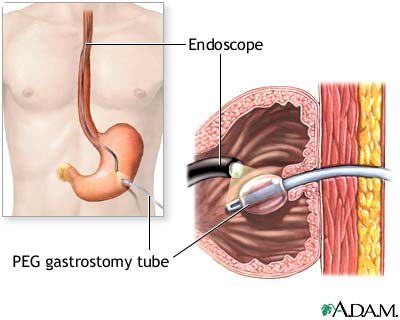Gastrostomy tube placement - series
Procedure, part 2

Alternatively, gastrostomy tubes can be placed under endoscopic guidance, using a much smaller incision (percutaneous endoscopic gastrostomy tube placement, or PEG). PEG tube placement can generally be performed under local anesthesia rather than general anesthesia. An endoscope is passed into the mouth, down the esophagus, and into the stomach. The surgeon can then see the stomach wall through which the PEG tube will pass. Under direct visualization with the endoscope, a PEG tube passes through the skin of the abdomen, through a very small incision, and into the stomach. A balloon is then blown up on the end of the tube, holding in place. PEG gastrostomy tubes avoid the need for general anesthesia and a large incision.
Update Date: 4/26/2010
Updated by: Neil K. Kaneshiro, MD, MHA, Clinical Assistant Professor of Pediatrics, University of Washington School of Medicine. Also reviewed by David Zieve, MD, MHA, Medical Director, A.D.A.M., Inc.
Related Page
Notice: The information provided herein should not be used during any medical emergency or for the diagnosis or treatment of any medical condition. A licensed physician should be consulted for diagnosis and treatment of any and all medical conditions. Call 911 for all medical emergencies. Links to other sites are provided for information only -- they do not constitute endorsements of those other sites. Copyright 1997-2012, A.D.A.M., Inc. Any duplication or distribution of the information contained herein is strictly prohibited.
